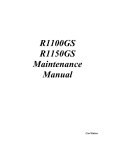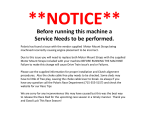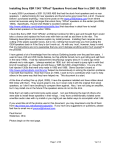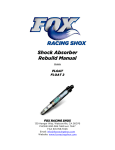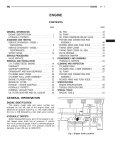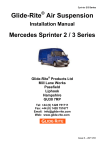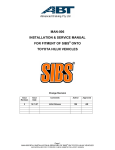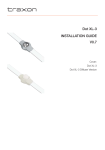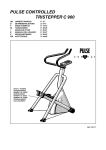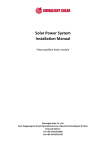Download Valkyrie Maintenance Guide
Transcript
Valkyrie Maintenance Guide Carl Kulow by Carl Kulow Send comments/corrections to [email protected] ISBN F6-1520CC First Edition Copyright: © 1997-2001 All Valkyrie Riders The author has done his best to produce accurate information However, neither he nor the editor nor the web publisher can assume liability for any damage or injury caused by any errors or omissions in this manual Use good sense and at your own risk! 2 TABLE OF CONTENTS VALKYRIE MAINTENANCE CHECKLIST .........................................................................................................................4 PARTS AND TOOL LIST ...................................................................................................................................................4 FUEL TANK REMOVAL.....................................................................................................................................................5 AIR FILTER CHANGE........................................................................................................................................................6 CRANKASE BREATHER...................................................................................................................................................6 SPARK PLUGS..................................................................................................................................................................7 TIMING BELTS ..................................................................................................................................................................7 VALVE ADJUSTMENT ......................................................................................................................................................8 ENGINE OIL AND FILTER CHANGE...............................................................................................................................10 CARBURETOR SYNCHRONIZATION .............................................................................................................................11 IDLE SPEED ADJUSTMENT ...........................................................................................................................................13 COOLANT CHANGE........................................................................................................................................................13 FINAL DRIVE GEAR OIL CHANGE .................................................................................................................................14 BRAKE AND CLUTCH FLUID .........................................................................................................................................15 BRAKE PADS ..................................................................................................................................................................16 FORK OIL ........................................................................................................................................................................16 CHECK BATTERY ...........................................................................................................................................................16 CHECK TIRES AND TIRE PRESSURE ...........................................................................................................................16 CHECK ALL NUTS AND BOLTS ....................................................................................................................................16 CHECK ALL AIR AND FLUID HOSE CLAMPS ...............................................................................................................16 CHECK ALL LIGHTS .......................................................................................................................................................16 TIRE CHANGE AND REAR SPLINE LUBE .....................................................................................................................17 SHOCK INSTALLATION INSTRUCTIONS ......................................................................................................................22 3 Valkyrie Maintenance Checklist • • • • • • • • • • • • • • • • • • • • • Fuel Tank Removal Air Filter Change Crankcase Breather Spark Plugs Timing Belts Valve Adjustment Engine Oil and Filter Change Carburetor Synchronization Idle Speed Adjustment Coolant Change Final Drive Gear Oil Change Brake and Clutch Fluid Brake Pads Fork Oil Check Battery Check Tires and Tire Pressure Check All Nuts and Bolts Check All Air and Fluid Hose Clamps Check All Lights Tire Change and Rear Spline Lube Shock Installation Instructions PARTS - TOOLS Tools sockets wrenches torque wrench hex sockets hex wrenches feeler gauges oil filter tool flashlight measuring cylinder Mityvac digital volt meter heat gun tire change tools Parts spark plugs oil filter air filter brake pads oil gear oil timing belts antifreeze compression washers 2 = oil drain, rear drive 1 = coolant drain 4 Misc. compressed air anti seize carb cleaner rag clear tubing (tygon) cycle jack Fuel Tank Removal Parts none Tools screwdriver phillips screwdriver 8mm socket 12mm socket ratchet long extension slip joint pliers needle nose pliers rag Warning: Gasoline is very combustible – avoid all sparks or flames. It is also a carcinogen. 1. Ride bike until you go onto reserve – getting excess gasoline weight out of the tank makes this job much easier. 2. Unlock front seat with key and remove the front seat. 3. Turn the fuel valve to OFF!!! 4. Insert a phillips screwdriver down the center off the fuel valve knob ~3 inches and unscrew the hidden screw until the whole chrome knob assembly comes loose from the actual fuel valve. You do not need to remove the chrome knob assembly, just pivot it down out of the way. 5. Remove the front tank bolt using an 8mm socket and long extension. 6. Remove the rear tank bolt using a 12mm socket. Pry up the rubber block under this bolt – it may be sticking to the frame plate. 7. Lift the back of the tank a couple of inches being careful not to catch the actual fuel valve on the “brake” line (clutch line). 8. With the back of the tank raised, pry off the small fuel vent hose at the very back center of the tank. You may or may not need to slide the clamp down the hose first with slip joint pliers. 9. You can now lift the tank a little higher and see the two hoses that are attached to the actual fuel valve. Lower the tank into place and go to the right side of the bike about 2 – 3 inches behind and level with the ignition switch, you will find these two hoses which are somewhat hidden. Pry off the small hose attached to the right side of the fuel valve – it comes off easily without removing the clamp. 10. Still working from the right side of the bike, rotate the clamp on the large fuel line so that you can get slip joint pliers on it. Slide the clamp down the fuel line. Pry off the fuel line. It will drip about a teaspoon of gas, so you may want to have a rag under it as you pry it off. 11. Slowly lift the tank being careful not to catch the fuel valve on the clutch line. Set the tank aside. Installation Reverse of the above with the following notes: 1. Slide the two small clamps into place on the hose before pushing the hoses on. 2. Wet the ends of the hoses slightly to make sliding them on easier 3. I used needle nose pliers to slide the two fuel valve hoses on from the right side behind the ignition switch. Don’t forget the large fuel line clamp. 4. Be sure the chrome knob assembly is pointed to the OFF position when connecting it to the fuel valve. CHECK VAC LINE FOR KINKS 5. Be sure that there are no kinks in any of the fuel and vacuum lines 5 Air Filter Change Parts air filter Tools screwdriver phillips screwdriver tank removal tools 1. 2. 3. 4. 5. 6. Remove the fuel tank. See Tank Removal instructions. Remove the 2 rear screws on the air filter housing and set them aside. Loosen the remaining 7 screws all the way, leaving them in place in the cover. Lift off the air filter cover taking note of the rubber gasket (top) Replace the air filter. Be sure the lower rubber gasket is in place. Install the air filter cover being sure that the top rubber gasket is in place. To insert the top gasket you can turn the cover upside down without the 7 screws falling out. Use a screwdriver to push the gasket into its groove so that it is well seated and won’t drop out when you turn the cover over to install it. 7. Tighten all 9 screws. 8. Install the fuel tank. Hint: With a helper you can change the filter while he holds up the "empty" tank. Loosen petcock lever & mounts first and lift front of tank use a stubby screwdriver. Crankcase Breather Parts none Tools slip joint pliers 1. Locate the 3 drain hoses below the right foot peg 2. Note that one of the hoses has a plug and clamp on the end of it 3. Squeeze the clamp with the pliers to open it slightly and slide the clamp up the hose ~1 inch 4. Pull the plug from the hose and let it drain into an old can 5. Install the plug 6. Slide the clamp back down over the plug using the pliers 6 Spark Plugs Parts spark plugs Tools spark plug socket short extension ratchet compressed air spark plug gauge anti-seize torque wrench 1. Remove the spark plug caps 2. Blow compressed air around the plug well – there is often dirt here that can fall into the cylinder when you remove the spark plug!!! Note: If you do not have an air compressor, you can get a compressed air tank at any Xmart automotive department, or you can get a small can of compressed air at any photo or computer supply store. 3. Remove the spark plugs and check each for abnormalities – carbon or oil deposits, burned electrodes, etc. 4. Check and set the gap on the new spark plugs to .031 - .035 inch gap (.8 - .9mm) using a wire spark plug gauge 5. Apply a tiny amount of anti-seize to the spark plug threads 6. Install the plugs by hand using only the spark plug socket and the short extension to avoid any possibility of crossthreading them 7. Torque the plugs to 12 ft.lb. (16 Nm) 8. Push the spark plug wire caps firmly onto the spark plugs Timing (Cam) Belts Note: Honda only calls for an inspection at 100K miles. Most automotive timing belts are replaced at 60K miles. I would suggest that you check the tension at each 12K service and change the belts at ~50K miles if you mostly ride hard or replace the belts at ~75K miles if you mostly do highway riding. 1. Remove the timing belt cover Warning: Use caution when removing the top left bolt near the round crank pulley cover. It has sealant on it and may break off. 2. Inspect the belts for cracks, worn teeth, contamination, etc. 3. Check the belt tension – it should deflect ~0.2 – 0.3 inches (5 - 7mm) in the center of the long straight side of the belt (the side opposite the tensioner) 4. See shop manual for tensioner adjustment and belt replacement 7 Valve Adjustment Tools Parts Allen sockets – 5mm, 6mm ratchet short extension oil drain pan newspaper sockets – 17mm box wrench – 10mm feeler gauges screwdriver none 1. 2. 3. 4. 5. 6. 7. 8. Engine cold!!! Bike on sidestand (or on cycle lift – less oil drips) Transmission in neutral!!! Remove both cam end covers, 3 inch square covers with one rounded side, 2 bolts each (5mm hex) at the rear end of each valve cover Place an oil drain pan under the left valve cover (~1/8 cup will drain), newspaper under the right valve cover (a few drops will drain) Remove the rubber plugs from the center of the valve cover bolts Remove both valve covers (6mm hex) – be sure the washer/sealing ring comes off with each bolt! Remove the timing cover, 3 inch round cover directly below the radiator, 3 bolts (5mm hex) Hint: Any of the covers removed above may stick slightly and you will need to tap them gently with a wooden or plastic screwdriver handle or the palm of your hand. 9. With the transmission in neutral, turn the crankshaft (17mm) where you removed the timing cover, counterclockwise (there is an arrow on the timing plate) and align the T1,2 mark on the timing plate to the index mark on the outside at 3 o’clock 10. Be certain the No.1 piston is at TDC (Top Dead Center)!!! – the intake and exhaust valves for No.1 should wiggle slightly in and out. If not, turn the crankshaft a full 360 degrees counterclockwise to the same T1,2 mark and check the valves again for “wiggle” Cylinder Location (the spark plug wires are also numbered as given below) Right side, front to rear = 1, 3, 5 Left side, front to rear = 2, 4, 6 Valve Clearance Intake = .006in. (.15mm) Exhaust = .009in. (.22mm) Valve Location Intake Valves are on the top (take air/gas in from the carbs) Exhaust Valves are on the bottom (exhaust to the exhaust pipes) 8 11. Insert the correct feeler gauge between the valve stem and the adjuster screw. There should be slight drag on the feeler gauge – be sure that you do not have the gauge canted or curved as you are measuring. You can use the “go, no go” method – a .008in. gauge should not go into the .006 intake; a .011 should not go into a .009 exhaust if adjusted properly. A .007 gauge will go into the intake and a .010 gauge will go into the exhaust, but will give a too tight drag. 12. If any valve needs adjusting, loosen the adjuster lock nut with a 10mm box wrench and turn the adjuster screw with a screwdriver to get the correct clearance – slight drag on the feeler gauge. 13. Slide the box wrench over the shaft of the screwdriver and hold the adjuster screw with the screwdriver while tightening the lock nut with the 10mm box wrench. 14. After tightening, double check the clearance. 15. Turn the crankshaft 120 degrees to align the T3,4 at the index mark. Check for wiggle at No.4 valves. Adjust if necessary. 16. Turn the crankshaft 120 degrees to align the T5,6 at the index mark. Check for wiggle at No.5 valves. Adjust if necessary. 17. Turn the crankshaft 120 degrees to align the T1,2 at the index mark. Check for wiggle at No.2 valves. Adjust if necessary. 18. Turn the crankshaft 120 degrees to align the T3,4 at the index mark. Check for wiggle at No.3 valves. Adjust if necessary. 19. Turn the crankshaft 120 degrees to align the T5,6 at the index mark. Check for wiggle at No.6 valves. Adjust if necessary. 20. Install the timing cover, 3 bolts (5mm hex) 21. Wipe any oil off the valve cover gaskets Hint: You may need to apply a small amount of TRV or similar sealer to each outside end of the cam housing. There are two spots at each end, top and bottom, of the round cam housing where the factory applied some sealant. In any case, be sure that none of the factory applied sealant is balled up and potentially keeping the valve cover gasket from sealing tightly. 22. Below and to the front of the right valve cover, remove the two sets of wire cables from the wire holder and gently pull out any extra slack to make it easier to reinstall the right valve cover. Hint: Do not over tighten any of the bolts to the 5 different covers when reinstalling. These are relatively small and fine threaded bolts and could easily break or strip. Keep your palm or fingers close to the head of the ratchet when tightening these bolts. 23. Insert the six valve cover bolts and washers (6mm hex). 24. Insert the wire cables back into the holder 25. Install the left valve cover, 6 bolts and washers (6mm hex) 26. Install both cam end covers, 2 bolts each (5mm hex) 27. Insert the black rubber plugs into the valve cover bolts 28. Run the engine; check for oil leaks 9 Engine Oil and Filter Change Parts oil filter 4 qts. oil (10W-40 or Mobil 1 15W-50) drain plug washer Tools oil filter tool ratchet torque wrench 17mm socket funnel or oil spout rubber gloves rag oil drain pan 1. Be sure engine is hot (go for a short ride) 2. Place oil drain pan under drain plug (bottom right side of engine) 3. Wear rubber gloves - oil is carcinogenic, plus when you accidentally touch the hot headers!!! or get hot oil!!! on your hands it won’t hurt as much 4. Remove the oil drain plug, 17mm socket – do not lose the washer located under the drain plug. Replace this crush washer every other time. 5. Remove the oil filter (front right of engine), oil filter tool and ratchet 6. Remove the oil filler cap (~6 inches above the right foot peg) to help draining 7. Let drain for ~10 min. 8. Straddle bike and hold upright or tip very slightly to the right to drain last of the oil 9. Install the drain plug with its washer and torque to 25 ft.lb. (34 Nm) 10. Apply a thin coat of oil to the new oil filter rubber gasket 11. Install the new oil filter and torque to 7 ft. lb. (10 Nm) or give it ¾ - 1 turn after first contact 12. Remove the oil filler cap – be careful not to lose the o-ring 13. Add 3.75 – 3.9 qts. of oil (NOT 4 qts.!!!) using funnel or oil spout 14. Install the oil filler cap 15. Run engine at idle for 2 –3 min. 16. Wait ~5 min.; straddle bike to hold it upright and check to be sure the oil level is at the upper mark on the dipstick – dipstick NOT screwed in 17. Check for any oil leaks at filter and drain plug 10 Carburetor Synchronization Parts none Tools vacuum gauge, 4 column hose clamp phillips screwdriver flatblade screwdriver thin gloves needle nose pliers 1. Be sure engine is hot (go for a short ride) 2. Remove the long chrome carburetor linkage covers – 3 phillips screws each side Note: If the radiator fan comes on while you are syncing the carbs, it will change your reference point. Some people disconnect the fan and point a house box fan at the front of the engine/radiator to keep things cool during synchronization. Others leave the radiator fan connected and either use a new reference point when it comes on or they wait for it to shut off and settle back to the original reference point. Note: The No.3 carb is the reference carb and cannot be adjusted – all 5 of the other carbs are adjusted to read the same as No.3 carb. Note: Carb Location (the spark plug wires are also numbered as given below) Right side, front to rear = 1, 3, 5 Left side, front to rear = 2, 4, 6 Note: Thin gloves and angled needle nose pliers make getting the hoses and caps back on much easier around the hot engine. Note: It is a good idea to check your vacuum gauge to be sure that all four columns read identically when connected to the same vacuum source. The line restrictors have been known to cause incorrect readings. You can get 3 T’s or Y’s from a pet (aquarium) supply store and connect all four vacuum gauge columns at one time to the No.3 intake manifold – they should all read the same. 3. Start the engine and clamp the vacuum hose that runs from the No.6 intake manifold to the fuel petcock. You need to keep a vacuum on the fuel petcock for fuel to flow – the vacuum would be lost when you removed this hose to sync carb No.6. After clamping the hose shut the engine off. Hint: If you do not have a hose clamp, you could use a hemostat or visegrips. 4. Use a flatblade screwdriver to push/pry the No. 3 and No.4 vacuum hoses off the intake manifold – you can leave the little hose clamp in place 5. As in step 4, remove the small caps from No.1 and No.5 – there are no vacuum hoses on these two 11 6. Connect the four column vacuum gauge to No.1, 3, and 5 intake manifolds on the right side and No. 4 on the left side where you removed the vacuum hose or cap Note: Be sure that the gauge and its hoses do not touch the hot exhaust pipes!!! 7. Start the engine and be sure that it is idling at ~900 rpm. The idle adjust is a black knob located between the No.1 and 3 intake manifolds on the right side of the bike - it is ~2 inches farther in from the backside of the intakes. It is easy to turn with one finger. Note: After starting the engine, be sure not to blip the throttle rapidly when using mercury gauges as you can suck the mercury into the engine!!! Let the throttle speed down slowly! Note: When using the screwdriver to turn the adjustment screw, be sure to use light pressure on the screw. Heavy pressure may affect the actual setting. 8. Adjust carbs No.1 and 5 to read the same as No.3. The adjustment screw is the blue painted phillips screw next to each carb. The No.3 carb has no adjustment screw. (No.4 is connected to the vacuum gauge but will be adjusted in a later step) Note: Honda specification calls for the carbs to be within 40mm (1.6 inches) of mercury, but you can do better – probably within 5 – 10mm. 9. Slowly rev the engine a couple of times and recheck the balance Note: Some people prefer to balance the carbs at ~3000 rpm (cruising speed) 10. Shut the engine off and remove the vacuum gauge hoses from No.1 and 5 intake manifolds 11. Reinstall the caps on No.1 and No. 5 intake manifolds 12. Remove the clamped vacuum hose from No.6 (leave the clamp on) and the cap from No.2 13. Move the vacuum gauge to the left side of the bike and connect the two free gauge hoses to No.2 and 6 intake manifolds (No.4 was connected in step 6) Note: If mercury got stuck in the vacuum gauge columns when you shut the engine off, you can blow into the end of the vacuum gauge hose to force the mercury back into the reservoir. 14. Repeat steps 7, 8, and 9 to balance carbs No.2, 4 and 6 on the left side 15. Shut the engine off and remove all four vacuum gauge hoses 16. Install the vacuum hoses and caps to all intake manifolds: Hose =No.3, 6, 4 Cap = No.1, 5, 2 17. Remove the clamp from No.6 18. Install the chrome linkage covers – 3 phillips screws each. Be sure to get the cable hooked on the front inside of the left linkage cover when installing. 19. Take bike out for a test drive 12 Idle Speed Adjustment Start the engine and be sure that it is idling at ~900 rpm. The idle adjust is a black or gray knob located between the No.1 and 3 intake manifolds on the right side of the bike - it is ~2 inches farther in from the backside of the intakes. It is easy to turn with one finger. Coolant Change Parts antifreeze – silicate free distilled water ONLY drain seal washer Tools 10mm socket drain pan phillips screwdriver Note: This procedure is often overlooked – be sure to change your coolant every two years to prevent cooling system corrosion. Note: Motorcycle Consumer News investigated a rash of water pump seal failures in Gold Wings and concluded the cause was from silicates found in regular automotive antifreeze. Be certain to use Honda motorcycle coolant or automotive coolant that is silicate free! 1. Be sure to do this procedure with a cold engine! 2. Loosen the setscrew in the radiator cap with phillips screwdriver 3. Follow the lower radiator hose down to the water pump housing on the front of the engine and remove the very bottom center drain bolt, 10mm 4. Remove the radiator cap 5. Drain the coolant into the drain pan Note: Dispose of the coolant in a safe manner. Ethylene glycol tastes sweet but is very deadly to animals which may come along and drink it if you drain it onto the ground. It is equally toxic to children which are attracted to its lovely color. 6. Reinstall the drain bolt with a new drain seal washer (careful – this bolt can break easily, 7 ft.lb) 7. Remove the left side cover to gain access to the coolant reservoir 8. Remove the reservoir mounting bolt and the breather hose by the cap 9. Dump the coolant into your drain pan 10. Reinstall the reservoir being careful that all the hoses are in place 11. Dilute the antifreeze 50:50 with distilled water – not tap water 12. Fill the radiator with ~ 4 quarts of this 50:50 mix 13. Fill the coolant reservoir to the upper line with ~ 1 quart of this 50:50 mix 14. You next want to bleed the air out by putting the transmission into neutral and starting the engine 15. Run the engine at idle for 2 –3 minutes and then blip the throttle 3 – 4 times to dislodge any trapped air bubbles 16. Shut engine off 17. Add coolant to the radiator and to the reservoir to bring up to the proper level 18. Install the reservoir cap and side cover 19. Install the radiator cap and its setscrew 13 Final Drive Gear Oil Change Parts synthetic gear oil 75W-90 drain plug washer Tools funnel, narrow neck clear tygon tubing measuring cylinder 17mm box wrench rag oil drain pan 1. Set the bike on its sidestand on a level surface 2. Place oil drain pan under drain plug (right side of rear tire) 3. Place a rag on the tire to catch any dripping gear oil 4. Remove the drain plug, 17mm box wrench – do not lose the washer located under the drain plug. Replace this crush washer every other time. 6. Remove the filler cap to help draining – do not lose the o-ring 7. Let drain for ~10 min. 8. Straddle the bike and hold it upright or tip very slightly to the right to drain the last of the oil 9. Clean the sludge and metal filings off the drain plug with the tip of a rag and perhaps a blast of carb or brake cleaner 10. Install the drain plug with its washer - 14 ft.lb. (20 Nm) Hint: Clear tygon tubing is available at most hardware stores and makes filling the final drive very easy with the right saddle bag in place. You need approximately 2 feet of tubing (OD ~9/16”; ID ~3/8”) that will fit over the neck of your funnel and also into the filler opening. Measuring cylinders are available at camera stores that sell darkroom supplies. 11. Thread the tygon tubing behind the right side saddle bag and into the filler opening 12. Insert the funnel into the other end of the tygon tubing 13. Measure 150cc (5.1oz) of synthetic gear oil 75W-90 (Mobil, Spectro, Amsoil, etc.) 14. Pour the gear oil into the funnel and let it drain down the tubing into the final drive Hint: With the bike held vertical, 150cc comes to just below the inside lower edge of the filler hole – not flowing out the filler opening with the bike on its sidestand 15. Install the oil filler cap with the o-ring in place – 9 ft.lb. (12 Nm) 16. Wipe any spilled gear oil off the tire and wheel 17. Check for any oil leaks after your next ride 14 Brake and Clutch Fluid Note: Brake fluid can ruin the bike’s paint, so cover the tank and any painted or plastic parts with a towel if you are adding or changing fluid!!! Front Brake Fluid Reservoir 1. Turn the handlebar to the left so the reservoir on the right handlebar is level 2. Check the fluid level in the sight glass of the reservoir 3. Add only DOT 4 brake fluid if the level is at or below the LOWER level mark Rear Brake Fluid Reservoir 1. Have a friend hold the bike upright 2. Check the fluid level through the sight hole, right side of the bike just in front of the sidecover. It is easier to see if you remove the plastic chrome reservoir cover 3. Add only DOT 4 brake fluid if the level is at or below the LOWER level mark Note: If either the front or rear is low on fluid, be sure to check the brake pads for wear! As the pads wear, more fluid is taken into the system. Clutch Fluid Reservoir 1. Same as Front Brake Fluid Reservoir above, but on the left handlebar Brake and Clutch Fluid Replacement – Bleeding the Brakes Note: Honda calls for a fluid change every 12K miles or every 2 years. Good brakes are too important to skip this relatively straight forward procedure. Note: There are some devices that aid in bleeding the brakes as you replace the fluid: 1. Mityvac is a small hand held vacuum pump that sucks the brake fluid down and out through the bleeder nipple at each brake caliper. It is available at most auto parts stores. 2. Speed Bleeder is a one way valve bleeder nipple that replaces your stock bleeder nipples. It is available at www.speedbleeder.com 3. One Man Brake Bleeder is a one way valve that attaches to your stock bleeder nipple via a hose. It is available at some auto parts stores. 4. A turkey baster is handy for removing the old fluid from the reservoir before you add the fresh fluid. Once you use it for brake fluid, do not return it to the kitchen – let your SO get a new one. Note: If bleeding by the standard method of pumping the lever, do not pull the lever all the way to the handlebar or you will force the caliper piston to far out and possible ruin the seal. This applies to the clutch and rear brake as well. Note: Check the shop manual for brake and clutch fluid replacement procedures. 15 Brake Pads Note: Check front and rear pads for wear and replace them if they are worn to the bottom of the wear indicator groove. Note: If either the front or rear brake fluid reservoir is low on fluid, be sure to check the brake pads for wear! As the pads wear, more fluid is taken into the system. Note: See the shop manual for brake pad replacement. Note: Be sure to check the brake fluid reservoir after replacing the pads as fluid is forced back into the reservoir by the new thicker pads – the reservoir may be too full. Fork Oil Honda does not mention fork oil changes in the maintenance schedule. An educated guess would put a fork oil change at perhaps 24K – 36K miles or every 2 years. Since there is no drain plug for the forks and you need to remove the forks to dump the oil, this procedure does not fall into the category of routine maintenance. Check with the shop manual if you wish to do this procedure yourself. Check Battery Note: If you have a sealed no maintenance battery, just check for any corrosion at the battery terminals. If you have a regular battery, you will have to check the battery acid level and bring it up to the upper level line with distilled water. Check Tires and Tire Pressure Note: Visually check the tires for any problems – wear, nails, tread separation, cupping, etc. Note: Check the tire pressure on “cold” tires. Most Valkyrie riders and tire manufacturers find that ~38 psi front and ~40 psi rear for one up riding is better than Honda’s recommended pressure. For two up riding or if you are carrying a lot of camping gear, try ~40 psi front and ~42 psi rear. Check All Nuts and Bolts Note: Get your open end/box wrenches, sockets, allen (hex) wrenches, etc. and go over your bike front to back, top to bottom, and check every nut and bolt for tightness. You are not retorqueing everything, just making sure that nothing is loose. Note: If you have the time and motivation, you may want to actually check the torque on critical fasteners. Check All Air and Fluid Hose Clamps Check All Lights 16 Tire Change and Rear Spline Lube Tools – Front Tools - Rear Allen (hex) socket set – 6mm ratchet short extension – 3” metric sockets – 12,14,22mm torque wrench phillips screwdriver small screwdriver soft mallet (plastic, rubber) awl bead breaker (JC Whitney) balancing stand (homemade) wood frame of 2x2” (16” sq. OD) 3 tire irons valve core tool wheel weights (ribbon) tire lube (dish soap) paint brush (for applying lube) Allen (hex) socket set – 8mm ratchet ratchet extension – 1 ½”, 3”, 10” sockets – 8,10,12,14,19,27mm torque wrench soft mallet (rubber, plastic) molybdenum disulfide paste (mdp) grease (regular) small pry bar - ~6” open end box wrench – 10mm Parts? exhaust gaskets? hub o-ring? flange o-ring? alcohol grease Front Wheel Removal 1. Raise bike slightly using Cycle Lift 2. Remove speedometer cable (phillips screw) on left side of wheel – tuck it out of the way into engine guard 3. Remove left and right brake calipers by removing 2 mounting bolts each (12mm) – Do NOT depress front brake lever while calipers are removed!!! 4. Unclip left brake hose from fender and hang caliper by the speedo cable clip out of the way 5. Let right caliper hang from fender (or support it with a piece of wire) 6. With a small screwdriver carefully pry the 4 chrome caps off the axle pinch bolts 7. Loosen right axle pinch bolts (6mm hex) – do NOT loosen the left side yet 8. Remove the axle bolt (22mm) from the right side (use bike tool kit if you do not have 22mm) 9. Loosen left axle pinch bolts (6mm hex) 10. Remove the axle from the left side by reinserting the axle bolt partway into the axle on the right side and gently tapping the axle bolt with a soft mallet (e.g. plastic or rubber) to drive the axle out to the left. Note the location of the spacer on the right and the orientation of the speedo gear box and its rotation stop in relation to the fork leg stop. Now remove the axle bolt and finish driving the axle most of the way out using a 14mm socket on a short extension, while sitting in front of the bike and supporting the tire with your feet. Insert an awl or phillips screwdriver into the crosshole in the left end of the axle and twist and pull it all the way out while supporting and aligning the tire with your feet. 11. Remove the spacer from the right hub 12. Remove the speedo gear box from the left hub 13. Roll tire out from the fender by tipping it slightly (raise jack if necessary) 14. Check wheel bearings on both sides for smoothness and quietness 15. Inspect break pads in both sets of calipers that they are not worn past the indicator grooves 17 Front Tire Change Hints: Warm the tires in the sun! A warm tire goes on much more easily. When levering the last of the tire bead onto the wheel, be absolutely certain the opposite bead is not seated but rather squeezed into the middle of the wheel. Put just the wheel, no tire on it, on the balancing stand and check for the heavy spot and use that rather than the tire stem for the heaviest spot. Use automotive door protector trim on your wheel rims to prevent tire iron damage. 1. Place wheel on wooden support frame to prevent rotor damage!!! 2. Mark direction of rotation on wheel with a pencil 3. Remove valve core 4. Break bead all around on both sides 5. Lube bead both sides (tire lube or dish soap) 6. Pry off first side with two tire irons (tape to avoid scratching the wheel) 7. Pry second side part way off from inside the wheel with tire iron(s) and then pound the rest off by hand using a rubber mallet (tire and rim vertical) 8. Align tire balance dots with tire stem!!! and correct direction of rotation!!! 9. Lube first bead of the new tire and push on with hands and knees 10. Lube second bead and push down with hands, knees, feet ~ 3/4 on 11. Using three tire irons pry tire on - the real secret is to be sure the opposite side of the tire is squeezed into the center of the wheel (use bead breaker if necessary) 12. Double check alignment of tire balance dots with valve stem!!! 13. Double check direction of rotation 14. Insert valve core, inflate to seat tire, inflate to 40 psi Front Tire Balance 1. Insert axle into wheel and place on balancing stand 2. Determine balance by taping assorted weights to wheel 3. Remove old weights with razor knife and alcohol if necessary 4. Precurve whole weight ribbon to same curvature as the wheel 5. Clean wheel with alcohol before sticking weight on Front Wheel Installation 1. 2. 3. 4. Lightly grease axle to prevent corrosion and make for easier removal Roll wheel under the front fender Insert right side spacer Grease inside of speedo gear box and insert on the left side being certain that the rotation stop on the speedo gear box is just behind (toward the radiator or rear) the stop on the left fork leg 5. Lift the wheel with your feet and align 6. Insert the axle from the left (of the bike) and push it in until it is flush with the outside of the fork leg (top to bottom) 7. Insert and torque the left (only!!!, not the right) axle pinch bolts (6mm hex) to 16 ft.lb. (22Nm) 8. Insert and torque the axle bolt on the right side (22mm) to 67 ft.lb. (90Nm) 9. Do NOT tighten the right axle pinch bolts yet!!! The correct sequence is critical to maintain correct fork alignment!!! 10. Gently spread the pads in the calipers with a tire iron or large screwdriver 18 11. Install both calipers (12mm) and torque the mounting bolts to 22 ft.lb. (30Nm) 12. Align the slots in the speedo cable and insert it into the speedo gear box – if the cable won’t go in all the way, gently push on the cable while turning the wheel – insert and gently tighten the phillips screw (careful – it can break easily) 13. Insert the brake lines into the holders on the fender 14. Insert the speedo cable into the wire holder on the left caliper 15. Check the front wheel for relatively free rotation (some brake pad drag) 16. Pump the front brakes until pressure returns!!!!!!!!!!! 17. Lower and remove the Cycle Lift 18. Straddle the bike, apply the front brakes and pump the front forks up and down several times to seat the axle (or you can compress the forks with straps and then tighten the right axle pinch bolts) 19. Only now do you tighten the right axle pinch bolts to 16 ft.lb. (22Nm) 20. Insert the chrome caps into the 4 axle pinch bolt heads 21. Pump the front brakes to be sure they are working!!! Rear Wheel Removal Note: The following instructions are for a Tourer. If you have a Standard, it may be easier to remove the shocks and raise and lower the rear wheel with a scissors jack to gain access to the axle while the bike is up on the Cycle Lift. In which case you would not remove the exhaust/mufflers. 1. Raise the bike up on Cycle Lift, rear tire just off the ground, transmission in first gear 2. Remove the left and right saddle bags, four bolts each (8mm) Note: For an easy bag removal kit see: http://www.rattlebars.com 3. Remove the two nuts (12mm) at each rear muffler hanger Note: It may be possible to skip Step 4 by forcing the mufflers out of the way by putting a wedge, such as a small piece of wood, between the muffler and the hanger Note: Sears has a ¼ inch drive 10mm flex socket that can make the next step easier 4. Remove the six nuts at the front exhaust headers (10mm + long extension, 10mm open end/box wrench for the 3 hard to reach nuts on the right inside exhaust – remove these 3 first). Leave the front most exhaust nut screwed on a little bit to hold the exhaust up as you pivot the muffler down in the next step. 5. Pull the muffler out from the rear hanger and let it swing down as far as it will go Note: I know that many owners are very reluctant to remove the bags and especially the exhaust system. The bags literally come off in seconds and make the job much easier. The exhaust comes off in a couple of minutes and greatly eases access to the axle and axle nut. 6. Remove the axle nut on the left side (27mm or 1 1/16” or tool kit) 7. Remove the rear brake caliper stop bolt (14mm) located in the swing arm ~2 inches below and to the front of the left bottom shock bolt 8. Spin the axle from the right side, very center of the final drive hub using 8mm hex to break loose any corrosion and ease removal of the axle 19 9. Install the axle nut partway onto the axle and using a 19mm socket and long extension drive the axle out to the right 10. Remove the axle nut and using just the long extension drive the axle out the rest of the way 11. Remove the rear break caliper and lay it on the left saddle bag mount or wire tie it out of the way 12. Remove collar/spacer from the left side center off the wheel 13. Pull the wheel to the left until it comes free of the final drive 14. Raise the bike 12 inches or so until the tire/wheel can be removed from under the rear fender 15. Check the rear pads for wear 16. Check the rear wheel bearings on each side for smooth and quiet rotation Rear Tire Change Use the wooden frame to protect the rotor To get the last part of the first bead on, I had to use a large 12” tire iron and pry against (fulcrum) the outer bead to force the inner first bead on. I’ve never had to do this before and could be because the tire was not sun warmed or it could be that Valkyrie rear tires are a bit harder to install. Otherwise same as the front Rear Wheel Installation and Rear Spline Lube 1. Using a small 6” pry bar, gently pry the final drive flange out of the right side of the wheel. The flange is the black star shaped piece with what looks like 5 bolts holding it to the wheel. These “bolts” are actually smooth pins. Be careful not to loose the plastic washer on the inside of the flange plate. 2. Carefully remove the large o-ring from the outside of the flange, just inside of the gear teeth 3. Carefully remove the large o-ring from the right side wheel hub, under where the flange was 4. Clean both o-rings and their grooves with a rag 5. Clean the 5 pins on the flange with a rag 6. Clean all the old grease off the flange, especially the gear teeth with a rag 7. Clean the old grease off the final drive teeth as best you can 8. Fill the hub o-ring groove with moly disulfide paste (mdp) (Honda, Belray), coat the oring with mdp and install 9. Coat the mating surface of the wheel hub (around the outside of the wheel bearing on the flange side) with mdp 10. Coat the large plastic washer with mdp 11. Coat the inside of the flange with mdp 12. Lightly coat the 5 flange pins with mdp 13. Push the flange onto the wheel hub being sure the inside o-ring and plastic washer are in place 14. Fill the outer flange o-ring groove with mdp, coat the o-ring with mdp and install Note: Replace the hub and flange o-rings perhaps every other tire change 15. Generously apply mdp to the flange teeth and the final drive teeth 16. Wipe clean the left (rotor) side bearing dust seal and its spacer/collar 17. Apply regular grease to the lips of the bearing dust seal 18. Insert the spacer/collar into the bearing dust seal 20 19. Clean any corrosion off the axle with fine sandpaper and grease lightly to help prevent corrosion and ease installation Note: Take a good look at the axle sleeve that runs through the final drive and note that it can easily pivot off center in any direction and thus prevent the wheel/flange from sliding in. Be sure this axle sleeve stays centered. 20. Loosen the 4 final drive mounting nuts (14mm socket + 1 ½ “ extension) a couple of turns until they are finger loose. This step is critical to achieve proper alignment of the final drive and prevent premature failure of the splines!!!! 21. Start the axle in from the right side a short ways 22. Lift the wheel into place on the final drive 23. Push the axle into place by hand and then gently tap it through just flush with the spacer/collar on the left side using a rubber mallet 24. Carefully spread the brake pads with a large screwdriver 25. While sliding the brake pads/caliper over the rotor, position the caliper bracket into place 26. Gently tap the axle the rest of the way through being sure that the axle is lined up with its hole in the swing arm Note: The following tightening sequence is critical to achieve proper spline alignment!!! 27. Install the rear brake stopper bolt (14mm) and torque to 51 ft.lb (69Nm) 28. Install the axle nut (27mm or 1 1/16”) and torque to 81 ft.lb. (110Nm) 29. Torque the 4 final drive nuts to 47 ft.lb. (64Nm) 30. Shift the transmission into neutral and turn the rear wheel by hand to check for free rotation 31. Pump the rear brake peddle until pressure returns!!!!! 32. Lift and pull outward on the muffler to install it into the rear hanger 33. Torque the muffler hanger nuts (12mm) to 25 ft.lb. (34Nm) 34. Install the 5 exhaust nuts (front most nut is already partway on) using 10mm socket on long extension and a 10mm open end box wrench for the hard to reach nuts and torque to 7 ft.lb. (10Nm) if you can, otherwise tighten by hand being careful not to over tighten 35. Install the saddle bags and 4 bolts each (8mm) 36. Check for exhaust leaks where you loosened the headers – replace exhaust gaskets if necessary 21 Progressive 416 Shock Installation Instructions Shock Removal If you have a Tourer, you do NOT have to remove the hardbags. Raise the bike slightly off the ground with Cycle Lift or equivalent. Set both shocks to #1 spring pre-load. Remove bottom shock bolt using 12mm socket (right shock) or 14mm socket (left shock), swivel, and long extension on your ratchet. Remove top shock bolt with 14mm socket on your ratchet. Gently pry the top of the shock off the mount with a screwdriver. Remove shocks. Right Shock Installation Both Progressive 416’s are identical, use either one. You want to install the shock with air outlet facing forward. Insert the thinnest black sleeve into the lower (red end) shock eye and press into place with a bench vise. (Pre-test the sleeve on the bolt for proper size before inserting into the shock.) Line up the lower shock eye with its mount, insert and finger tighten the bolt (12mm). (Tom Mitchell found it necessary to drill out one of the large thin brass washers to get the .020” min. space. I did not do this because there was not enough space on my bike. Check your own bike for the .020” min. space and act accordingly) The top shock eye does not get a sleeve. Very carefully raise or lower the Cycle Lift to align the top shock eye with its mount (N.B. swing the shock forward out of the way when lowering the lift, so you do not smash the top of the shock if the lift lowers too quickly!!!) Insert and finger tighten the top bolt (14mm) Left Shock Installation Same as the right shock EXCEPT: Insert the thickest black sleeve into the lower shock eye. (pre-test on the bolt first). The left lower shock bolt is 14mm. The left lower shock bracket may be a tight fit for the shock with its sleeve. Torque Values With all 4 shock bolts installed and finger tightened use a torque wrench to set the following values: Both top bolts (14mm) = 20 ft.lbs. Right lower bolt (12mm) = 17 ft.lbs. Left lower bolt (14mm) = 25 ft.lbs. 22 Air Line Installation The air fill T valve can be plastic cable tied (zip tie) to the frame in a suitable location or it can be permanently installed on the front plastic battery / seat release lock cover as suggested by Rob Weber. To do so, remove both sidecovers – pull loose at rear grommet first, then bottom grommet, then swing cover forward to unhinge front tab. Remove the 10mm bolts on each side holding the front cover in place – do not lose the spacer sleeves! Put masking tape below the seat lock and put a mark 1 ½” directly below the CENTER of the seat lock. Working on the left side of the bike, swing the front cover toward you slightly and drill a small pilot hole at the mark and then a 5/16” final hole. Do not mount the fill valve yet! Run the air lines from the shocks to the fill valve. Connect all air fittings as given in the Progessive instructions – finger tighten only! Inflate to 50 psi at the fill valve – it only takes a very small amount of air, be careful! Use soap suds to check all fittings, both shocks and fill valve, for leaks. Install the fill valve into the front cover using the nuts and washers supplied. Use plastic zip ties to hold the air lines in place. Reinstall front cover and side covers. Adjust (experiment) the air shocks for solo = ~ 10 – 25 psi two up = ~ 40 – 70 psi. Web publishing courtesy Rattlebars Mfg. Visit us at rattlebars.com 23























